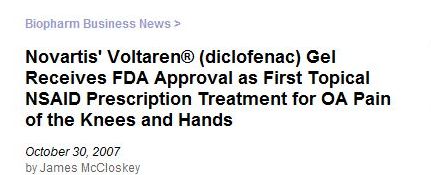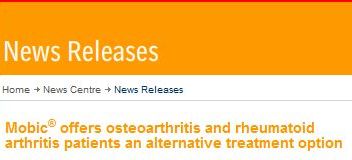 - Discussion:
- Discussion:
- non steroidals exert their actions by inhibiting isoforms of cyclo-oxygenase 1 and 2;
- cox 1: expressed in the stomach and kidneys;
- cox 2:
- cox 2 receptor is not normally expressed in synovial tissue;
- regulates inflammatory response and is responsible for disease symptoms;
- Specific Agents:
- Aspirin
- Propionic Acids:
- Naproxen
- Oxaprozin
- Ibuprofen
- Ketoprofen / Oruvail
- 100 mg, 150 mg, or 200 mg - extended release daily dosing;
- Indoleacetic Acids:
- Sulindac / Clinoril
- Indomethacin
- Etodolac / Lodine:
- 200-400 mg q 6-8 hrs; (1200 mg/day divided doses)
- Lodine XL 400 mg or 500 mg PO qd;
- Oxicams:
- Piroxicam / Feldene
- Phenylacetic Acids:
- Diclofenac / Volteren / Arthrotec
- Misc:
- Diflunisal / Dolobid
- Fenoprofen / Nalfon
- Meclofenamate / Meclomen
- Phenylbutazone
- Salicylate
- Tolmentin
- Relafen (Nabumetone):
- available in 500 mg and 750 mg tablets;
- usual dose is 1000 mg per day, but upto 2000 mg may be needed in some cases;
- metabolized in the liver and therefore no dose restrictions are need w/ renal insufficiency;
- Cox 2 Inhibitors:
- highly selective cyclooxygenase-2 (COX-2) inhibitors have no effect on platelet aggregation and bleeding time;
- celecoxib / celebrex
- available in 100 mg and 200 mg tab;
- theoretically is safe for patients taking warfarin;
- patients w/ a sulfa allergy may show a hypersensitivity reaction;
- in the study by Dahlen B, et al (2001), the authors studied the effect of celebrex on patients with reactive airway disease.
- 17 women and 10 men had stable chronic asthma, with no exacerbations and with stable medication use during the prior three months;
- before each study visit, leukotriene antagonists and long-acting bronchodilators were withheld for at least two days, and short-acting bronchodilators for at least six hours;
- criterion for inclusion in trial was a 20 % drop in the forced expiratory volume in one sec after the inhalation of lysine aspirin (3) on the first visit.
- patients did not have bronchoconstriction or extrapulmonary reactions after a graded oral challenge with increasing doses of celecoxib (suspensions of 10, 30, and 100 mg), given every second hour;
- on the final day of the study, each patient initially ingested 200 mg of celecoxib suspension, followed two hours later by the commercially available 200-mg capsule, without pulmonary or systemic reactions;
- authors concluded that celecoxib, a selective COX-2 NSAID, did not induce bronchospasm in patients w/ syndrome of asthma and aspirin intolerance;
- references:
- Celecoxib in patients with asthma and aspirin intolerance. The Celecoxib in Aspirin-Intolerant Asthma Study Group.
- Celecoxib: a review of its use in osteoarthritis, rheumatoid arthritis and acute pain.
- Complications:
- note that the two main complications of NSAID use are peptic ulcer formation and ATN;
- in patients at risk, consider the use of alternative medications such as ultram, tylenol, or narcotics;
- bleeding:
- most often takes the form of a bleeding peptic ulcer, but if heparin or coumadin are used together other forms of life threatening hemorrhage may occur;
- relative risk of GI bleeding from NSAIDS: Tolmentin (8.5), Piroxican (6.4), Fenoprofen (4.3), Naprosyn (4.3), Sulindac (4.2), Indomethacin (3.8), and Ibuprofen (2.3);
- ref: Nonsteroidal anti-inflammatory drug use and increased risk for peptic ulcer disease in elderly persons.
- NSAIDS should not be given to patients on heparin or coumadin (instead consider salicylate);
- peptic ulcer disease:
- misoprostol / cytotec:
- is a prostaglandin E1 analog, and is used to prevent NSAID induced ulcers;
- usual dose: 200 micrograms 4 times daily;
- can cause miscarriage if taken during pregnancy;
- references:
- Controversies in the detection and management of nonsteroidal antiinflammatory drug-induced side effects of the upper gastrointestinal tract.
- Nonsteroidal anti-inflammatory drug use and increased risk for peptic ulcer disease in elderly persons.
- renal failure / insufficiency
- renal insufficiency may be due to ATN or intersitial nephritis;
- elderly patients w/ pre-existing renal insufficiency who are on diuretics are especially at risk;
- patients with early NSAID related renal complications may note water retention (bloated face or feet), hematuria, or sudden increase in blood pressure;
- special attention should be given to patients on ACE inhibitors and NSAIDS;
- these patients may develop a fatal hyperkalemia;
- other risk factors for this complication include pre-existing renal insufficiency, CHF, and/or diabetes;
- in the report by Fored CM, et al, in a nationwide, population-based, case-control study of early-stage chronic renal failure in Sweden, face-to-face interviews
were conducted with 926 patients with newly diagnosed renal failure and 998 control subjects, of whom 918 and 980, respectively, had complete data;
- results Aspirin and acetaminophen were used regularly by 37 % and 25 %, respectively, of patients with renal failure and by 19 percent and
12 percent, respectively, of the controls;
- regular use of either drug in the absence of the other was associated with an increase by a factor of 2.5 in risk of chronic renal failure from any cause;
- references:
- Risk of kidney failure associated with the use of acetaminophen, aspirin, and nonsteroidal antiinflammatory drugs.
- Original Article: Analgesic Use And Chronic Renal Disease.
- Medical Progress: Renal Syndromes Associated with Nonsteroidal Antiinflammatory Drugs.
- Acetaminophen, Aspirin, and Chronic Renal Failure
- pulmonary reactions:
- in some patients with asthma, the administration of aspirin and other NSAIDS leads to bronchospasm
- there is some evidence that Cox-2 medications are less likely to cause this complication.
- ref: Celecoxib in patients with asthma and aspirin intolerance. The Celecoxib in Aspirin-Intolerant Asthma Study Group.
- stroke and MI:
- Nonaspirin NSAIDs, Cyclooxygenase 2 Inhibitors, and the Risk for Stroke.
- Risk of hospitalization for myocardial infarction among users of rofecoxib, celecoxib, and other NSAIDs: a population-based case-control study.
- Risks and benefits of COX-2 inhibitors vs non-selective NSAIDs: does their cardiovascular risk exceed their gastrointestinal benefit? A retrospective cohort study.
The effect of piroxicam on the metabolism of isolated human chondrocytes.
Nonsteroidal anti-inflammatory drugs: effects on kidney function.
Renal toxicity of the NSAID drugs. Murray MD and Brater DC. Ann Rev Pharmacol Toxicol. 1993;33:435-465.
Fatal outcome of interaction between warfarin and a non-steroidal anti-inflammatory drug.
Aspirin-induced asthma: advances in pathogenesis and management.
Influence of diclofenac (group of nonsteroidal anti-inflammatory drugs) on fracture healing
Effects of nonsteroidal anti-inflammatory drugs on post-operative renal function in normal adults.
Alternatives to Total Knee Replacement:
Autologous Hamstring Resurfacing Arthroplasty

